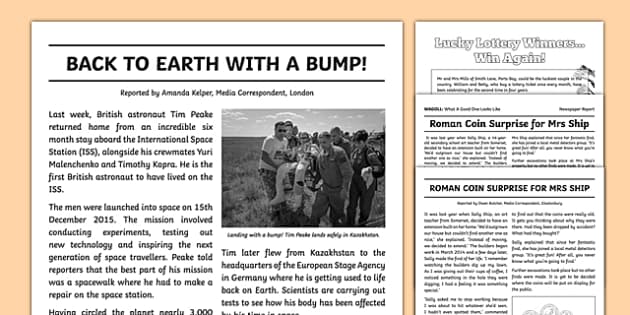News Articles Things To Know Before You Get This
News Articles Things To Know Before You Get This
Blog Article
The Buzz on News Articles
Table of ContentsNews Articles Fundamentals ExplainedThe Single Strategy To Use For News ArticlesExamine This Report on News ArticlesGet This Report about News ArticlesNews Articles Can Be Fun For Everyone
Good understanding of various subjects offers trainees a competitive side over their peers. Although digital and social networks are readily obtainable, we must not fail to remember just how crucial it is to check out the newspapers. Moms and dads need to try and inculcate the practice of reviewing a newspaper as an everyday regimen to proceed the tradition of the adored print medium.Newspaper article also consist of at least one of the adhering to crucial qualities about the intended audience: distance, importance, timeliness, human rate of interest, anomaly, or effect. The related term journalese is in some cases made use of, usually pejoratively, to describe news-style writing. Another is headlinese. Newspapers normally adhere to an expository writing style.
Within these limitations, news stories also intend to be comprehensive. Among the bigger and a lot more revered papers, justness and balance is a major variable in offering details.
Newspapers with a global target market, for example, often tend to utilize a more official style of creating. News Articles.; typical style overviews consist of the and the United States Information Style Publication.
Some Known Facts About News Articles.
As a rule, journalists will not use a long word when a brief one will certainly do. They make use of subject-verb-object building and construction and vivid, energetic prose (see Grammar). They provide anecdotes, instances and metaphors, and they hardly ever depend on generalizations or abstract ideas. News writers attempt to stay clear of making use of the very same word more than when in a paragraph (sometimes called an "echo" or "word mirror").
However, headlines sometimes omit the topic (e.g., "Leaps From Watercraft, Catches in Wheel") or verb (e.g., "Pet cat lady lucky"). A subhead (also subhed, sub-headline, subheading, caption, deck or dek) can be either a subordinate title under the major headline, or the heading of a subsection of the post. It is a heading that precedes the major text, or a team of paragraphs of the major message.

Additional billboards of any of these kinds might appear later in the short article (especially on succeeding web pages) to lure more analysis. Such signboards are additionally utilized published here as tips to the short article in other sections of the publication or website, or as ads for the piece in other magazine or websites. Typical structure with title, lead paragraph (summary in bold), other paragraphs (details) and call info.

Instance of a hard-lead paragraph NASA is recommending one more area task. The firm's budget plan request, announced today, consisted of a strategy to send out another objective to the Moon. This time around the company wishes to develop a lasting facility as a jumping-off factor for various other room experiences. The budget plan demands approximately $10 billion for the task.
The NASA announcement came as the company asked for $10 billion of appropriations for the job. An "off-lead" is the 2nd crucial front web page news of the day. The off-lead shows up either in the top left edge, or directly listed below the lead on the. To "bury the lead" is to begin the article with background info or details of additional relevance to the readers, requiring them to learn more deeply right into a write-up than they need to need to in order to discover the important factors.
Fascination About News Articles
Common use is that one or 2 sentences each create their very own paragraph. Journalists usually describe the company or structure of a newspaper article as an upside down pyramid. The crucial and most intriguing aspects of a tale are placed at the start, with supporting details adhering to in order of lessening relevance.
It Web Site enables individuals to check out a topic to only the depth that their inquisitiveness takes them, and without the imposition of information or subtleties that they could take into consideration unnecessary, but still making that information offered to more interested viewers. The inverted pyramid framework also enables write-ups to be trimmed to any type of arbitrary size during design, to suit the room offered.
Some writers start their tales with the "1-2-3 lead", yet there are numerous kinds of lead readily available. A twist can refer to multiple points: The last story in the news broadcast; a "happy" story to finish the program.
Longer posts, such as magazine cover articles and the items that lead the inside sections of a newspaper, are called. Function look at this website tales differ from straight news in numerous methods. Foremost is the absence of a straight-news lead, many of the time. Rather of supplying the essence of a tale up front, attribute writers may try to entice viewers in.
Things about News Articles
A feature's very first paragraphs often relate an appealing minute or occasion, as in an "anecdotal lead". From the particulars of a person or episode, its sight quickly broadens to abstract principles concerning the tale's topic.

The Editor's Tool kit: A Recommendation Overview for Beginners and Professionals (2001) Allan M. Siegal and William G. Connolly. The New York Times Manual of Design and Use: The Authorities Design Overview Made Use Of by the Writers and Editors of the Globe's A lot of Authoritative Paper (2002) M. L. Stein, Susan Paterno, and R.
Report this page